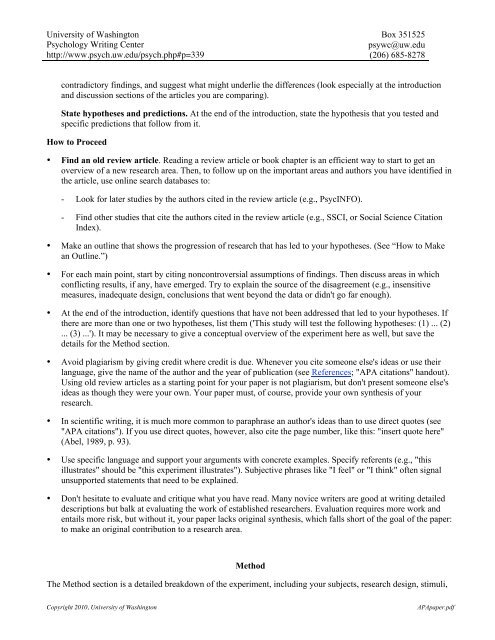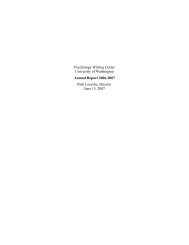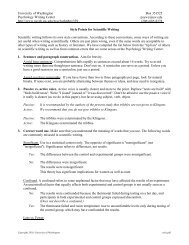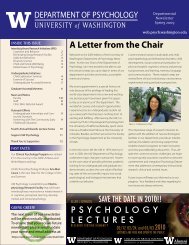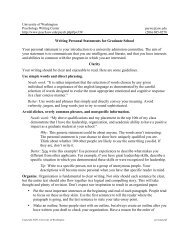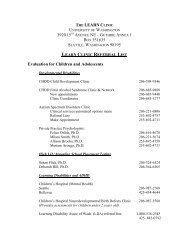Writing an Empirical Paper in APA Style - University of Washington ...
Writing an Empirical Paper in APA Style - University of Washington ...
Writing an Empirical Paper in APA Style - University of Washington ...
You also want an ePaper? Increase the reach of your titles
YUMPU automatically turns print PDFs into web optimized ePapers that Google loves.
<strong>University</strong> <strong>of</strong> Wash<strong>in</strong>gton<br />
Psychology <strong>Writ<strong>in</strong>g</strong> Center<br />
http://www.psych.uw.edu/psych.php#p=339<br />
Box 351525<br />
psywc@uw.edu<br />
(206) 685-8278<br />
contradictory f<strong>in</strong>d<strong>in</strong>gs, <strong>an</strong>d suggest what might underlie the differences (look especially at the <strong>in</strong>troduction<br />
<strong>an</strong>d discussion sections <strong>of</strong> the articles you are compar<strong>in</strong>g).<br />
State hypotheses <strong>an</strong>d predictions. At the end <strong>of</strong> the <strong>in</strong>troduction, state the hypothesis that you tested <strong>an</strong>d<br />
specific predictions that follow from it.<br />
How to Proceed<br />
• F<strong>in</strong>d <strong>an</strong> old review article. Read<strong>in</strong>g a review article or book chapter is <strong>an</strong> efficient way to start to get <strong>an</strong><br />
overview <strong>of</strong> a new research area. Then, to follow up on the import<strong>an</strong>t areas <strong>an</strong>d authors you have identified <strong>in</strong><br />
the article, use onl<strong>in</strong>e search databases to:<br />
- Look for later studies by the authors cited <strong>in</strong> the review article (e.g., PsycINFO).<br />
- F<strong>in</strong>d other studies that cite the authors cited <strong>in</strong> the review article (e.g., SSCI, or Social Science Citation<br />
Index).<br />
• Make <strong>an</strong> outl<strong>in</strong>e that shows the progression <strong>of</strong> research that has led to your hypotheses. (See “How to Make<br />
<strong>an</strong> Outl<strong>in</strong>e.”)<br />
• For each ma<strong>in</strong> po<strong>in</strong>t, start by cit<strong>in</strong>g noncontroversial assumptions <strong>of</strong> f<strong>in</strong>d<strong>in</strong>gs. Then discuss areas <strong>in</strong> which<br />
conflict<strong>in</strong>g results, if <strong>an</strong>y, have emerged. Try to expla<strong>in</strong> the source <strong>of</strong> the disagreement (e.g., <strong>in</strong>sensitive<br />
measures, <strong>in</strong>adequate design, conclusions that went beyond the data or didn't go far enough).<br />
• At the end <strong>of</strong> the <strong>in</strong>troduction, identify questions that have not been addressed that led to your hypotheses. If<br />
there are more th<strong>an</strong> one or two hypotheses, list them ('This study will test the follow<strong>in</strong>g hypotheses: (1) ... (2)<br />
... (3) ...'). It may be necessary to give a conceptual overview <strong>of</strong> the experiment here as well, but save the<br />
details for the Method section.<br />
• Avoid plagiarism by giv<strong>in</strong>g credit where credit is due. Whenever you cite someone else's ideas or use their<br />
l<strong>an</strong>guage, give the name <strong>of</strong> the author <strong>an</strong>d the year <strong>of</strong> publication (see References; "<strong>APA</strong> citations" h<strong>an</strong>dout).<br />
Us<strong>in</strong>g old review articles as a start<strong>in</strong>g po<strong>in</strong>t for your paper is not plagiarism, but don't present someone else's<br />
ideas as though they were your own. Your paper must, <strong>of</strong> course, provide your own synthesis <strong>of</strong> your<br />
research.<br />
• In scientific writ<strong>in</strong>g, it is much more common to paraphrase <strong>an</strong> author's ideas th<strong>an</strong> to use direct quotes (see<br />
"<strong>APA</strong> citations"). If you use direct quotes, however, also cite the page number, like this: "<strong>in</strong>sert quote here"<br />
(Abel, 1989, p. 93).<br />
• Use specific l<strong>an</strong>guage <strong>an</strong>d support your arguments with concrete examples. Specify referents (e.g., "this<br />
illustrates" should be "this experiment illustrates"). Subjective phrases like "I feel" or "I th<strong>in</strong>k" <strong>of</strong>ten signal<br />
unsupported statements that need to be expla<strong>in</strong>ed.<br />
• Don't hesitate to evaluate <strong>an</strong>d critique what you have read. M<strong>an</strong>y novice writers are good at writ<strong>in</strong>g detailed<br />
descriptions but balk at evaluat<strong>in</strong>g the work <strong>of</strong> established researchers. Evaluation requires more work <strong>an</strong>d<br />
entails more risk, but without it, your paper lacks orig<strong>in</strong>al synthesis, which falls short <strong>of</strong> the goal <strong>of</strong> the paper:<br />
to make <strong>an</strong> orig<strong>in</strong>al contribution to a research area.<br />
Method<br />
The Method section is a detailed breakdown <strong>of</strong> the experiment, <strong>in</strong>clud<strong>in</strong>g your subjects, research design, stimuli,<br />
Copyright 2010, <strong>University</strong> <strong>of</strong> Wash<strong>in</strong>gton <strong>APA</strong>paper.pdf


